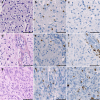Immunopathological characterization of ovarian teratomas associated with anti-N-methyl-D-aspartate receptor encephalitis
- PMID: 30857565
- PMCID: PMC6410529
- DOI: 10.1186/s40478-019-0693-7
Immunopathological characterization of ovarian teratomas associated with anti-N-methyl-D-aspartate receptor encephalitis
Abstract
Encephalitis with anti-NMDAR antibodies (NMDAR-E) is a severe autoimmune neurological disorder, defined by a clinical presentation of encephalitis and the presence of IgG targeting the GluN1 subunit of NMDA receptors in the CSF. An underlying ovarian teratoma is commonly associated with this autoimmune disease suggesting a role of the tumor in immunopathogenesis. In this study, we characterized the salient histopathological features of 27 ovarian teratomas associated with NMDAR-E (3 immature and 24 mature teratomas) and 40 controls without associated encephalitis. All but one NMDAR-E-associated teratomas contained a nervous tissue component, while less than 40% of control teratomas did (p < 0.001). GluN1 expression by teratomatous nervous tissue seemed to be more often glial in NMDAR-E teratomas than in control teratomas (73% vs. 29%, p < 0.05). Strikingly, 3 out of 24 NMDAR-E-associated mature teratomas contained neuroglial tissue exhibiting histopathological features of central nervous system neuroglial tumor, while such glioma-like features are exceptionally described in the literature on ovarian teratomas. Moreover, NMDAR-E associated teratomas differed from sporadic ovarian teratomas by consistent and prominent infiltration of the nervous tissue component by immune cells, comprised of T- and B-cells and mature dendritic cells organized in tertiary lymphoid structures, with IgG and IgA deposits and plasma cells in close contact to the neuroglial tissue.These data demonstrate an association between massive infiltration of NMDAR-E-associated teratomas by immune cells and particular glial features of its neuroglial component, suggesting that this glial tissue might be involved in triggering or sustaining the anti-tumor response associated with the auto-immune neurological disease.
Keywords: Anti-NMDAR encephalitis; Autoimmunity; Ovarian teratoma.
Conflict of interest statement
Ethics approval and consent to participate
Written consent was obtained from all patients, and this study was approved by the institutional review board of the University Claude Bernard Lyon 1 and Hospices Civils de Lyon.
Competing interests
The authors have declared that they have no competing interests.
Publisher’s Note
Springer Nature remains neutral with regard to jurisdictional claims in published maps and institutional affiliations.
Figures






Similar articles
-
Ovarian Teratomas in Women With Anti-N-methyl-D-Aspartate Receptor Encephalitis: Topography and Composition of Immune Cell and Neuroglial Populations Is Compatible With an Autoimmune Mechanism of Disease.Am J Surg Pathol. 2019 Jul;43(7):949-964. doi: 10.1097/PAS.0000000000001249. Am J Surg Pathol. 2019. PMID: 31021857
-
Abnormal neurons in teratomas in NMDAR encephalitis.JAMA Neurol. 2014 Jun;71(6):717-24. doi: 10.1001/jamaneurol.2014.488. JAMA Neurol. 2014. PMID: 24781184
-
Immunopathological significance of ovarian teratoma in patients with anti-N-methyl-d-aspartate receptor encephalitis.Eur Neurol. 2014;71(1-2):42-8. doi: 10.1159/000353982. Epub 2013 Nov 27. Eur Neurol. 2014. PMID: 24296881
-
The Association of Ovarian Teratoma and Anti-N-Methyl-D-Aspartate Receptor Encephalitis: An Updated Integrative Review.Int J Mol Sci. 2021 Oct 9;22(20):10911. doi: 10.3390/ijms222010911. Int J Mol Sci. 2021. PMID: 34681570 Free PMC article. Review.
-
Fulminant course in a patient with anti-N-methyl-D-aspartate receptor encephalitis with bilateral ovarian teratomas: A case report and literature review.Medicine (Baltimore). 2018 Apr;97(15):e0339. doi: 10.1097/MD.0000000000010339. Medicine (Baltimore). 2018. PMID: 29642173 Free PMC article. Review.
Cited by
-
Surgical procedures and plasma exchange for ovarian teratoma-associated anti-N-methyl D-aspartate receptor encephalitis: a case report and review of literature.Front Oncol. 2023 Dec 19;13:1238087. doi: 10.3389/fonc.2023.1238087. eCollection 2023. Front Oncol. 2023. PMID: 38169855 Free PMC article.
-
Chemical peritonitis resulting from spontaneous rupture of a mature ovarian cystic teratoma: a case report.Acta Med Litu. 2019;26(4):217-226. doi: 10.6001/actamedica.v26i4.4207. Acta Med Litu. 2019. PMID: 32355460 Free PMC article.
-
Paraneoplastic AQP4-IgG-Seropositive Neuromyelitis Optica Spectrum Disorder Associated With Teratoma: A Case Report and Literature Review.Neurol Neuroimmunol Neuroinflamm. 2021 Jul 20;8(5):e1045. doi: 10.1212/NXI.0000000000001045. Print 2021 Jul. Neurol Neuroimmunol Neuroinflamm. 2021. PMID: 34285095 Free PMC article. Review.
-
Infiltration of plasma cells in colorectal adenocarcinoma associated with autoimmune encephalitis.Ann Clin Transl Neurol. 2021 Feb;8(2):498-503. doi: 10.1002/acn3.51283. Epub 2021 Jan 5. Ann Clin Transl Neurol. 2021. PMID: 33400852 Free PMC article.
-
Cervical lymph nodes and ovarian teratomas as germinal centres in NMDA receptor-antibody encephalitis.Brain. 2022 Aug 27;145(8):2742-2754. doi: 10.1093/brain/awac088. Brain. 2022. PMID: 35680425 Free PMC article.
References
-
- Bost C, Chanson E, Picard G, Meyronet D, Mayeur M-E, Ducray F, Rogemond V, Psimaras D, Antoine J-C, Delattre J-Y, Desestret V, Honnorat J (2018) Malignant tumors in autoimmune encephalitis with anti-NMDA receptor antibodies. J Neurol. 10.1007/s00415-018-8970-0 - PubMed
Publication types
MeSH terms
Supplementary concepts
Grants and funding
LinkOut - more resources
Full Text Sources
Other Literature Sources
Medical
Miscellaneous

